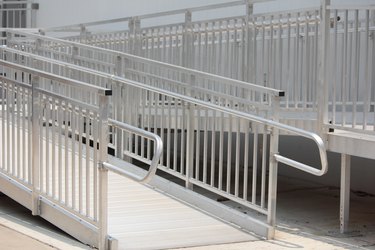
Ramps are built in place of or in addition to steps to make it possible for people in wheelchairs to enter a building. The slope of a ramp is an important factor in determining how easy the ramp is to ascend and descend, and ramps built in public locations need to meet ADA requirements for the slope. Dimensions usually depend on the space available to construct the ramp. You can calculate the slope by using a simple equation: rise/run.
ADA Guidelines for Ramps
Video of the Day
The Americans with Disabilities Act provides guidelines for wheelchair ramps to make them safe and as accessible as possible. A ramp that's too steep is difficult to go up, and it's dangerous for someone in a wheelchair to go down since it makes them go faster than they may want.
Video of the Day
According to the ADA, a wheelchair ramp for a commercial or public building must have a slope of 1:12, which is about a 5-degree incline. This means that for a 30-inch rise, the ramp would need to be 30 feet long. There must also be a 5 foot by 5 foot flat area, without any kind of obstructions, at the top of the ramp.
Residential ramps can have a steeper slope, which makes it easier to fit the ramp into an often smaller area, such as a ramp in a garage. The maximum slope at home should be 3:12, which is close to 15 degrees. However, if you're using the ramp for someone in a wheelchair or scooter, this might be a little too steep for comfort.
Finding the Rise and Run
Measure the height of the ramp from the high end to the ground straight down using a tape measure. If the low end of the ramp is not on the ground, measure vertically from the highest point of the ramp to the lowest point of the ramp. This is called the rise.
You also need to measure the ramp's horizontal dimension from one end to the other, which is called the run. You'll need to measure the base of the ramp, not the angled distance. Both the rise and the horizontal distance need to be measured using the same units, such as feet or inches.
Calculating the Slope
Divide the length of the wheelchair ramp by the height. This will be the second number in your ratio. The first number is always one. If the ramp measures 12 feet long and the rise is 2 feet, you would divide 12 by 2 to get 6, and your ratio would be 1 to 6. This means that for every foot you go up, you will need 6 feet of ramp to get you there.
It's also important to understand that two completely different ramps can have the same slope. For instance, a 12-foot ramp with a 1-foot rise has a slope of 1 to 12, while a ramp that is 120 feet long and a 10-foot rise will have the same slope.
Calculating Ramp Degrees
To calculate the angle of the ramp in degrees, divide your ratio to get a decimal. Then take the arc tangent of the quotient using a scientific calculator to get the angle. For example, a ramp with a 1-to-12 slope yields the decimal 0.083. The arc tangent of this number is approximately 5 degrees.